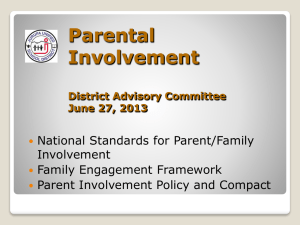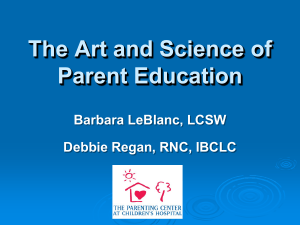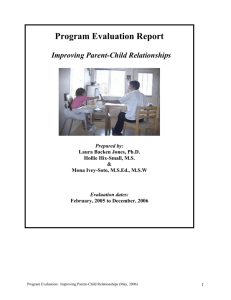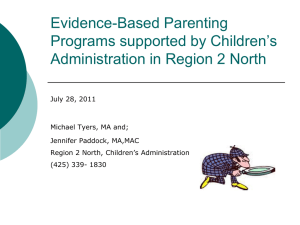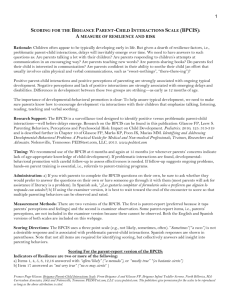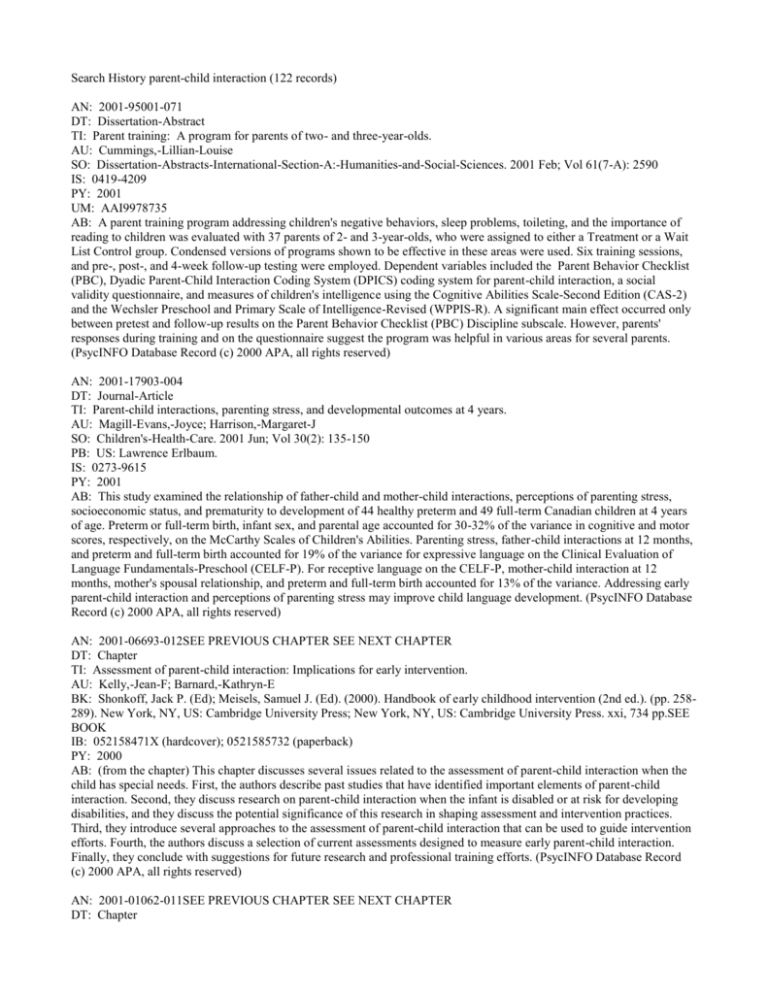
Search History parent-child interaction (122 records)
AN: 2001-95001-071
DT: Dissertation-Abstract
TI: Parent training: A program for parents of two- and three-year-olds.
AU: Cummings,-Lillian-Louise
SO: Dissertation-Abstracts-International-Section-A:-Humanities-and-Social-Sciences. 2001 Feb; Vol 61(7-A): 2590
IS: 0419-4209
PY: 2001
UM: AAI9978735
AB: A parent training program addressing children's negative behaviors, sleep problems, toileting, and the importance of
reading to children was evaluated with 37 parents of 2- and 3-year-olds, who were assigned to either a Treatment or a Wait
List Control group. Condensed versions of programs shown to be effective in these areas were used. Six training sessions,
and pre-, post-, and 4-week follow-up testing were employed. Dependent variables included the Parent Behavior Checklist
(PBC), Dyadic Parent-Child Interaction Coding System (DPICS) coding system for parent-child interaction, a social
validity questionnaire, and measures of children's intelligence using the Cognitive Abilities Scale-Second Edition (CAS-2)
and the Wechsler Preschool and Primary Scale of Intelligence-Revised (WPPIS-R). A significant main effect occurred only
between pretest and follow-up results on the Parent Behavior Checklist (PBC) Discipline subscale. However, parents'
responses during training and on the questionnaire suggest the program was helpful in various areas for several parents.
(PsycINFO Database Record (c) 2000 APA, all rights reserved)
AN: 2001-17903-004
DT: Journal-Article
TI: Parent-child interactions, parenting stress, and developmental outcomes at 4 years.
AU: Magill-Evans,-Joyce; Harrison,-Margaret-J
SO: Children's-Health-Care. 2001 Jun; Vol 30(2): 135-150
PB: US: Lawrence Erlbaum.
IS: 0273-9615
PY: 2001
AB: This study examined the relationship of father-child and mother-child interactions, perceptions of parenting stress,
socioeconomic status, and prematurity to development of 44 healthy preterm and 49 full-term Canadian children at 4 years
of age. Preterm or full-term birth, infant sex, and parental age accounted for 30-32% of the variance in cognitive and motor
scores, respectively, on the McCarthy Scales of Children's Abilities. Parenting stress, father-child interactions at 12 months,
and preterm and full-term birth accounted for 19% of the variance for expressive language on the Clinical Evaluation of
Language Fundamentals-Preschool (CELF-P). For receptive language on the CELF-P, mother-child interaction at 12
months, mother's spousal relationship, and preterm and full-term birth accounted for 13% of the variance. Addressing early
parent-child interaction and perceptions of parenting stress may improve child language development. (PsycINFO Database
Record (c) 2000 APA, all rights reserved)
AN: 2001-06693-012SEE PREVIOUS CHAPTER SEE NEXT CHAPTER
DT: Chapter
TI: Assessment of parent-child interaction: Implications for early intervention.
AU: Kelly,-Jean-F; Barnard,-Kathryn-E
BK: Shonkoff, Jack P. (Ed); Meisels, Samuel J. (Ed). (2000). Handbook of early childhood intervention (2nd ed.). (pp. 258289). New York, NY, US: Cambridge University Press; New York, NY, US: Cambridge University Press. xxi, 734 pp.SEE
BOOK
IB: 052158471X (hardcover); 0521585732 (paperback)
PY: 2000
AB: (from the chapter) This chapter discusses several issues related to the assessment of parent-child interaction when the
child has special needs. First, the authors describe past studies that have identified important elements of parent-child
interaction. Second, they discuss research on parent-child interaction when the infant is disabled or at risk for developing
disabilities, and they discuss the potential significance of this research in shaping assessment and intervention practices.
Third, they introduce several approaches to the assessment of parent-child interaction that can be used to guide intervention
efforts. Fourth, the authors discuss a selection of current assessments designed to measure early parent-child interaction.
Finally, they conclude with suggestions for future research and professional training efforts. (PsycINFO Database Record
(c) 2000 APA, all rights reserved)
AN: 2001-01062-011SEE PREVIOUS CHAPTER SEE NEXT CHAPTER
DT: Chapter
TI: Parent-child interaction play assessment.
AU: Smith,-David-T
BK: Gitlin-Weiner, Karen (Ed); Sandgrund, Alice (Ed); et-al. (2000). Play diagnosis and assessment (2nd ed.). (pp. 340370). New York, NY, US: John Wiley & Sons, Inc. xvi, 775 pp.SEE BOOK
IB: 0471254576 (hardcover)
PY: 2000
AB: (from the book) Provides the reader with an overview of the issues involved in observing and rating parent-child
interactions. Additionally, the author presents the Parent-Child Interaction Play Assessment (P-CIPA) method. The P-CIPA
is a developmentally scaled system of rating structured and unstructured interactions. While geared toward observing
parent-child interplay, the scale is demonstrated to be of value in the diagnostic assessment of specific problems exhibited
by the individual child. Thus, it also provides for the identification of target behaviors needed in developing treatment plans
and strategies. Case material incorporated in this chapter shows the strengths of this technique in analyzing parent-child
behaviors and in coding the reciprocal nature of such interactions. Further, the author offers validity and reliability data.
(PsycINFO Database Record (c) 2000 APA, all rights reserved)
AN: 2001-00697-001
DT: Journal-Article
TI: Role taking and socialization in single-parent families. .
AU: Tsushima,-Teresa; Gecas,-Viktor
SO: Journal-of-Family-Issues. 2001 Apr; Vol 22(3): 267-288
PB: US: Sage Publications Inc.
IS: 0192-513X
PY: 2001
AB: Examined the conditions and consequences of role taking in single-parent families. First, the authors discuss the
theoretical relevance of role taking for parent-child interaction. Second, they suggest some conditions for parental role
taking. Third, the authors consider how social class and family structure affect role taking in single-parent families. They
propose that in addition to role taking in the dyadic parent-child relationship, 2 other forms of role taking are consequential
for child socialization and family relations. One is specific to triadic relationships, the other to the family unit. Second-order
role taking occurs when a parent elicits the perspective of the spouse in understanding the child. Third-order role taking,
similar to G. H. Mead's (1934) concept of the "generalized other" as the vantage point for role taking, occurs when a parent
elicits the perspective of the family as a whole. The authors explore these ideas in a qualitative study of 17 single and 17
married parents. (PsycINFO Database Record (c) 2000 APA, all rights reserved)
AN: 2000-95006-113
DT: Dissertation-Abstract
TI: Parent-child attunement therapy: Development of a program for children one to three years old.
AU: Paravicini,-Stephanie-Fabienne
SO: Dissertation-Abstracts-International:-Section-B:-The-Sciences-and-Engineering. 2000 Apr; Vol 60(9-B): 4901
IS: 0419-4217
PY: 2000
UM: AAI9945876
AB: There is a growing body of literature regarding infant development and the importance of early childhood experiences
upon the lifespan development. The past decade has seen a significant trend in the conception of infant development within
a relational perspective, but little data exists regarding the effects of maltreatment and high-risk parent-child relationships
on the development of the young infant and toddler. Infancy represents a time when families are both at higher risk for
physical abuse and neglect, and when there is a greater opportunity for establishing positive long lasting parent-child
interactions. Parent-Child Attunement Therapy (PCAT) is a program that has been designed and developed as an
intervention program aimed at working with parents or caretakers and their children within the ages of one to three years
old, who have been identified 'at-risk' for maltreatment. PCAT is an expansion of the already existing Parent-Child
Interaction Therapy (PCIT), modified to meet the particular developmental needs of young infants and toddlers. Such
modifications were primarily based upon developmental models, in particular Jean Piaget's model of intellectual
development and Robert Kegan's Constructive-Developmental model of human development. PCAT's main objectives are
to enhance the parent-child relationship, to provide the caretaker with a better understanding of the toddler's developmental
needs, to promote more age appropriate activities and interactions, to support the toddler's acquisition of normal
developmental milestones, and finally to provide the caretaker with more age appropriate skills to manage problematic child
or infant behaviors. The first part of the project consists of presenting a theoretical framework for the program-mainly
Piaget's model of intellectual development and Kegan's Constructive-Developmental model. Next there is an overview of
the literature regarding child maltreatment, in particular physical abuse, and its effects on development. There then is a
presentat! ion of PCIT, as well as a presentation of the development of a theoretically driven PCAT curriculum. This
presentation explains basic areas of curriculum development, including session topics, a schedule of procedures, an
assessment protocol, and tools and materials to be used in the program. (PsycINFO Database Record (c) 2000 APA, all
rights reserved)
AN: 2000-95006-106
DT: Dissertation-Abstract
TI: The Dyadic Parent-Child Interaction Coding System II (DPICS II): Reliability and validity with father-child dyads.
AU: Foote,-Rebecca-Clark
SO: Dissertation-Abstracts-International:-Section-B:-The-Sciences-and-Engineering. 2000 Apr; Vol 60(9-B): 4886
IS: 0419-4217
PY: 2000
UM: AAI9945969
AB: The reliability and validity of the Dyadic Parent-Child Coding System II (DPICS II) with father-child dyads were
assessed in the present study. The DPICS II is the revised version of a behavioral observation coding system used in
research and clinical settings to describe the quality of parent-child dyadic interactions. The DPICS II contains 25 categories
to code parents' and children's verbal and nonverbal behavior. The study participants were sixty father-child dyads
representing a clinic-referred group (n = 30) and a non-problem comparison group ( n = 30). The children in the clinicreferred group were participants in a large treatment outcome study (N = 100) for preschool children with behavior
problems. All clinic-referred participants had met diagnostic criteria for Oppositional Defiant Disorder. The data on the
clinic-referred families used in the present study were collected as part of the families' standard initial assessment in the
larger outcome study. The father-child pairs in the comparison group were recruited from the Gainesville, FL, community
through advertisements. To be included in the study, the children in the comparison group could not meet diagnostic criteria
for Oppositional Defiant Disorder. The two groups were compared on several measures including the Parenting Stress Index
(PSI), the Parental Locus of Control Scale - Short Form (PLOC-SF), the Eyberg Child Behavior Inventory (ECBI), and the
DPICS II behavior observations. Videotapes of the father-child dyads were coded by observers trained to use the DPICS II.
The primary coders were blind to the hypotheses of this study. Thirty percent of the videotapes for each group, randomly
selected, were re-coded to evaluate reliability. Reliability was assessed using intraclass correlations and Cohen's kappa.
Overall, the DPICS II categories were shown to have acceptable reliability estimates. Significant differences between
groups were found on DPICS II variables, providing evidence for the discriminative validity of the coding sy! stem.
Furthermore, the DPICS II demonstrated convergent validity by correlating significantly with scores on the ECBI, the
PLOC-SF, and the parent and child scales of the PSI. Recommendations for improving DPICS II are discussed. (PsycINFO
Database Record (c) 2000 APA, all rights reserved)
AN: 2000-95004-146
DT: Dissertation-Abstract
TI: Parent stress, depression, social support, daily life context, and parenting practices among economically disadvantaged
fathers and mothers.
AU: Watkins-Victorino,-Lisa-M
SO: Dissertation-Abstracts-International:-Section-B:-The-Sciences-and-Engineering. 2000 Mar; Vol 60(8-B): 4258
IS: 0419-4217
PY: 2000
UM: AAI9940636
AB: The purpose of this study was to examine a model that hypothesized that parent stress, depression, and social support
would be significantly related to hostile, inductive, behavioral, and permissive parenting practices, with gender differences
between fathers and mothers in the relationship between these variables. Twenty single parent fathers and 39 single parent
mothers completed the study. Participants completed a questionnaire and participated in a semi-structured interview.
Multiple regression analyses were conducted to determine the predictive ability of parent stress, depression, and social
support in relation to each of the four categories of parenting practices. In general, the results suggested that parent stress
and social support were significant predictors of hostile and permissive parenting practices. The results of independent t
tests indicated significant interaction effects between parent and child gender and hostile and permissive parenting practices.
In addition, an exploratory analysis was conducted to examine the influence of daily life context on parenting practices.
Qualitative analyses were conducted and two themes emerged as important variables in understanding parenting practices.
Identified as frustration and lack of control over the parent-child interaction these variables were quantified to be used in
further analyses. Multiple regression analyses were conducted with these variables added to the predictors. The addition of
these variables did not increase the predictive ability of hypothesized predictors. Limitations of this study and suggestions
for future research on parenting practices is discussed. (PsycINFO Database Record (c) 2000 APA, all rights reserved)
AN: 2000-95001-175
DT: Dissertation-Abstract
TI: Children's questions, parental answers and other observations: A cross-cultural exploratory study.
AU: Sharifzadeh,-Virginia-Shirin
SO: Dissertation-Abstracts-International-Section-A:-Humanities-and-Social-Sciences. 2000 Feb; Vol 60(7-A): 2364
IS: 0419-4209
PY: 2000
UM: AEH9939239
AB: The interactions of 24 pairs of preschool age children and their parents from four different cultures were recorded by
the parents during the activity of sharing five non-scripted illustrated books. The focus of the research was to determine
possible differences across cultures in the frequency and patterns of children's questions and parental reactions to the
questions. Families were roughly matched for children's age range, mothers years of education, socioeconomic status, and
recency of immigration. The recordings were then translated into English and transcribed. An open coding analysis led to
five themes, 16 categories and 26 properties. The themes of quantity of parent-child interaction, children's questions,
parental responses, parental questions, and parental strategic use with their categories and properties were further analyzed
for cross cultural patterns. The findings revealed that while the majority of the Latino mothers chose to tell the story
themselves, most of the Iranian mothers delegated the story telling to their children, the Euro-American mothers opted for a
conversational style, and the Chaldean mothers took the role of probers. Another general conclusion was that parental style
of interaction influenced the question/answer dynamic between the parent and the child. One theory developed by this study
was that children's questions flourish more in styles that allow the child a 'temporal space'. The interaction style also
influenced the frequency of parental questions. Finally, groups were found to differ in their use of the text to emphasize
issues of family bonds and conduct and discipline. While the cross-cultural conclusions of this study are limited due to a
small sample size and insufficient control of interfering variables, the findings of the study point to the diversity of
parent/child interaction styles and the need to understand them in our multicultural society. An understanding of the
parent/child communication styles can help educators better serve the need of child! ren from ethnically diverse
backgrounds. The study recommends that future research in this area employ larger samples and better control of interfering
variables. (PsycINFO Database Record (c) 2000 APA, all rights reserved)
AN: 2000-16500-003
DT: Journal-Article
TI: Fathers' qualitative and quantitative involvement: An investigation of attachment, play, and social interactions.
AU: Kazura,-Kerry
SO: Journal-of-Men's-Studies. 2000 Fal; Vol 9(1): 41-57
PB: US: Mens Studies Press.
IS: 1060-8265
PY: 2000
AB: Examined fathers' involvement levels in father-child relationships. 27 fathers (mean age 35.54 yrs), 27 mothers (mean
age 31.95 yrs), and their children (aged 12-26 mo) completed interviews and the Parent-Child Caregiving Questionnaire.
Parent-child interaction was observed in play laboratory conditions concerning attachment behaviors, play interactions, and
social interactions. Results show that although fathers were not as involved as mothers in child-rearing activities, children
played at higher levels with their fathers. Children securely attached to their fathers played at significantly higher levels than
did children insecurely attached to their fathers. Conversely, mothers with secure attachments to their children were more
responsive and facilitative, and their children actively engaged in more social interaction, than those in insecure motherchild relationships. Findings suggest that play is important for father-child relationships, whereas mother-child relationships
revolve around social interactions. (PsycINFO Database Record (c) 2000 APA, all rights reserved)
AN: 2000-07065-006SEE PREVIOUS CHAPTER SEE NEXT CHAPTER
DT: Chapter
TI: Maternal employment: Effects of social context.
AU: Hoffman,-Lois-Wladis
BK: Taylor, Ronald D. (Ed); Wang, Margaret C. (Ed). (2000). Resilience across contexts: Family, work, culture, and
community. (pp. 147-176). Mahwah, NJ, US: Lawrence Erlbaum Associates, Inc., Publishers. xiii, 386 pp.SEE BOOK
IB: 0805833471 (hardcover)
PY: 2000
AB: (from the chapter) The present review begins with a summary of the research that has examined the direct relationship
between the mother's employment status and child outcomes and then concentrates on the 3 variables that have emerged as
most likely to be mediators of child outcomes: the father's role, the mother's state of well-being, and parent-child interaction
patterns. A final section considers the possibility that ethnicity moderates the effects of maternal employment on families
and children. (PsycINFO Database Record (c) 2000 APA, all rights reserved)
AN: 2000-02556-002
DT: Journal-Article
TI: A survival analysis of parent-child interaction in early intervention.
AU: Lee,-Sunghee; Kahn,-James-V
SO: Infant-Toddler-Intervention. 2000 Sep; Vol 10(3): 137-156
PB: US: Singular Publishing Group Inc.
IS: 1053-5586
PY: 2000
AB: Studied the occurrence and timing of successful interaction by mother-child dyads in an early intervention program
serving those with established or at-risk conditions for developmental disabilities. 33 dyads of 15-40 yr old mothers and
their 1-22 mo olds were observed during 3 8-min sessions videotaped at the 5th, 10th, and 15th mo after the initiation of
intervention. The children's diagnoses included cerebral palsy, developmental delay, Down syndrome, drug exposure,
prematurity, seizure disorder, speech/language delay and visual impairment. All the dyads displayed unsuccessful
interactions in the beginning as measured by the Parent-Infant Interaction Scale, which was also used to rate the videotaped
sessions. Interactive data from 2 trained raters were analyzed using survival analysis. Results show that by 15 mo, about
half the dyads experienced an event that was defined as a successful interaction. The event was most likely to occur during
the 6th-10th mo after the start of intervention. The mother's marital status significantly predicted differences in the patterns
of event occurrence. The findings are discussed with relation to the effectiveness of early intervention and future research
on parent-child interaction in early intervention. (PsycINFO Database Record (c) 2000 APA, all rights reserved)
AN: 2000-00771-005SEE PREVIOUS CHAPTER SEE NEXT CHAPTER
DT: Chapter
TI: Parent-child interaction and children's well-being: Reducing conduct problems and promoting conscience development.
AU: Gardner,-Frances; Ward,-Sarah
BK: Buchanan, Ann (Ed); Hudson, Barbara. (2000). Promoting children's emotional well-being. (pp. 95-127). New York,
NY, US: Oxford University Press. xiv, 258 pp.SEE BOOK
IB: 0192631748 (paperback)
PY: 2000
AB: (from the chapter) Conduct problems in childhood are detrimental to emotional well-being. Children with conduct
problems have increased rates of depression, peer problems, and school failure. This chapter discusses the importance of
parenting in its contribution to child behavior. The authors examine the definition of children's conduct problems, why
conduct problems are so important, why the development of conscience is important, research methods for assessing
parenting style and its contribution to child behavior, parenting and conduct problems, and parenting and conscience
development. (PsycINFO Database Record (c) 2000 APA, all rights reserved)
AN: 2000-00656-004
DT: Journal-Article
TI: Methodological issues in the direct observation of parent-child interaction: Do observational findings reflect the natural
behavior of participants?
AU: Gardner,-Frances
SO: Clinical-Child-and-Family-Psychology-Review. 2000 Sep; Vol 3(3): 185-198
PB: US: Kluwer Academic/Plenum Publishers.
IS: 1096-4037
PY: 2000
AB: Examined evidence for the utility and validity of direct observational techniques for answering particular research and
clinical questions. Observational techniques often involve recording behavior in settings that are relatively unnatural for
families. However, it is argued that construct validity of observational methods depends partly on whether the findings are
representative of participants' typical everyday behavior. Evidence is reviewed concerning whether observational findings
are affected by the presence of the observer, and by 2 factors that have been neglected in the literature, namely the type of
task imposed by the observer (e.g., directing parent and child to play rather than observing spontaneous interaction) and the
location of the observations (e.g., clinic or laboratory rather than home). The review suggests that the presence of an
observer does not necessarily distort the nature of interactions. However, the small number of studies in this area suggests
that interactions in structured or artificial settings are not necessarily representative of those normally taking place at home.
(PsycINFO Database Record (c) 2000 APA, all rights reserved)
AN: 1999-11958-002
DT: Journal-Article
TI: Importance of early intervention for disruptive behavior problems: Comparison of treatment and waitlist-control
groups.
AU: McNeil,-Cheryl-B; Capage,-Laura-C; Bahl,-Alisa; Blanc,-Holly
SO: Early-Education-and-Development. 1999 Oct; Vol 10(4): 445-454
PB: US: Wide Range Inc.
IS: 1040-9289
PY: 1999
AB: The stability of young children's behavior problems and the effectiveness of an early intervention approach known as
Parent-Child Interaction Therapy are examined. Participants were 32 families with young children (aged 2.5-8.6 yrs) who
were referred for treatment of disruptive behavior. The families were divided into 2 groups: the waitlist-control and
treatment groups. Dependent measures were administered at both Assessment 1 (the time of referral) and Assessment 2 (the
end of treatment for the treatment group; immediately prior to treatment for the waitlist-control group). No significant
differences were found between the waitlist-control and treatment groups at Assessment 1 on the dependent variables, the
Child Behavior Checklist, Eyberg Child Behavior Inventory, and Parenting Stress Index. However, the behavior of the
treatment group improved over the course of approximately 3 mo of Parent-Child Interaction Therapy, while the behavior of
the waitlist-control group continued to be problematic at the end of a similar time period. (PsycINFO Database Record (c)
2000 APA, all rights reserved)
AN: 1999-11931-008
DT: Journal-Article
TI: The relationship of childhood psychopathology and maternal adult attachment interview.
AU: Kyung-Sook,-Lee; Yee-Jin,-Shin; Kim,-Hae-Yean
SO: Korean-Journal-of-Developmental-Psychology. 1999; Vol 12(1): 103-115
PB: South Korea: Korean Psychological Association.
IS: 1229-0718
PY: 1999
AB: Knowledge of maternal state of mind with respect to attachment, may provide insight into etiology or maintenance of
problematic parent-child interaction and development of child psychology. Ss were 26, 2-8 yr olds (and their mothers)
referred to a child psychiatric clinic and 26, 3-6 yr old normal comparison children and their mothers. Maternal state of
mind with respect to attachment was assessed by the Adult Attachment Interview. The results of this study are as follows:
among clinic S's mothers, 3.8% were classified as autonornous, 26.9% were classified as dismissing, 19.2% were classified
as preoccupied and 50% were classified as unresolved disorganized. Among normal S's mothers, 50% were classified as
autonomous, 20.8% were classified as dismissing, 16.7% were classified as preoccupied and 12.5% were classified as
unresolved/disorganized. In particular, unresolved/disorganized maternal attachment was overrepresented in the clinic
group. (PsycINFO Database Record (c) 2000 APA, all rights reserved)
AN: 1999-03826-008
DT: Journal-Article
TI: Introduction to the Parent-Child Interaction Assessment.
AU: Holigrocki,-Richard-J; Kaminski,-Patricia-L; Frieswyk,-Siebolt-H
SO: Bulletin-of-the-Menninger-Clinic. 1999 Sum; Vol 63(3): 413-428
PB: US: Menninger Foundation.
IS: 0025-9284
PY: 1999
AB: The Parent-Child Interaction Assessment (PCIA) is a procedure developed to yield data about parental attunement as
well as other aspects of parent, child, and dyadic functioning. The procedure involves videotaping parents and children ages
4-10 yrs as they go on an imaginary trip to the zoo together. They begin with a short free-play interaction and then "play
out" several scenarios with toy people, animals, and blocks. After cleaning up the toys, the parent and child each are shown
the videotape of their interaction. The parent and the child are interviewed about what he or she and the other person are
doing, thinking, feeling, and wanting. This article describes the development and contemporary psychoanalytic theoretical
basis of the PCIA. A coding system under development and potential research and clinical applications are discussed. Case
examples of 2 dyads, 1 a mother in her late 20s with a 6.1-yr-old daughter and the other a mother in her early 30s with a 4.9yr-old son, are provided to illustrate the PCIA. (PsycINFO Database Record (c) 2000 APA, all rights reserved)

